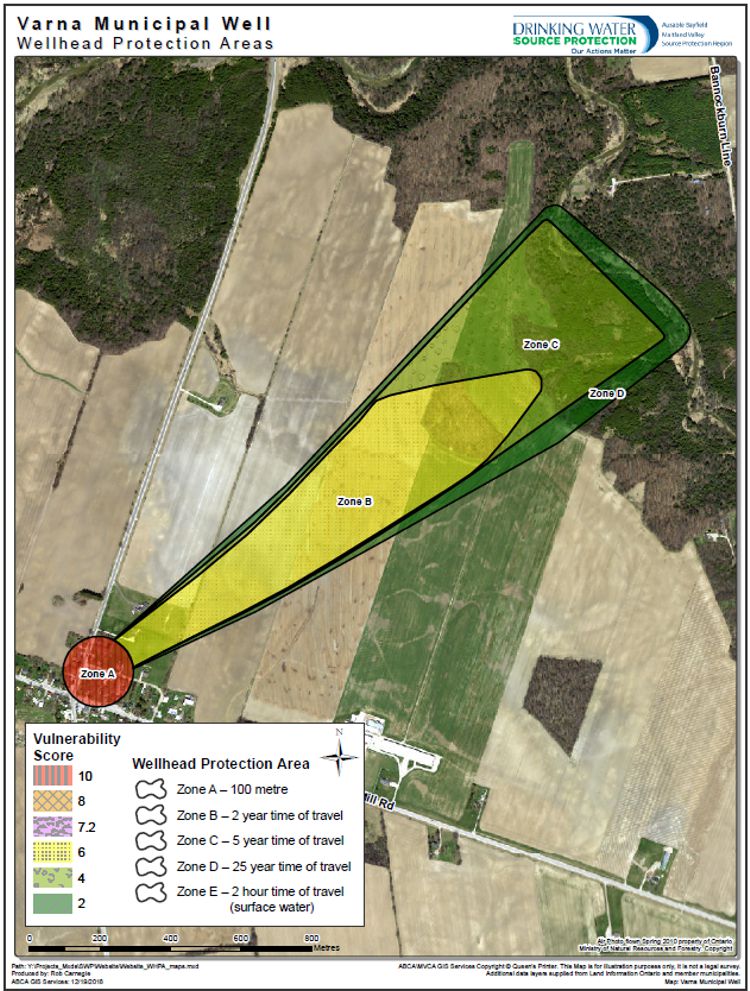Protecting drinking water sources in Varna
The following is for local information purposes and may be subject to change.
Municipality
Municipality of Bluewater
Impacts of Plans
A risk management plan can address how products are stored and where a spill kit/spill plan is located.
The Province of Ontario has identified 22 activities that can pose a threat to municipal drinking water sources and to which source protection planning policies apply.
In the Municipality Bluewater, these activities could be:
- Septic systems. They need to be inspected every five years in Wellhead Protection Area A.
- Fuel storage – e.g., Basement home heating fuel and bulk fuel.
- Agricultural activities – e.g., Manure application is prohibited within 100 metres of the municipal well.
- Hazardous waste – e.g., Used oil.
(If these activities exist in WHPA–A they may require a risk management plan. ) - Dense non-aqueous phase liquids (DNAPLs) – These heavy chemicals include metal or oil paints, solvents, degreasers, metal cleaners, creosote or other heavier than water products. In zones A, B, and C risk management plans are required for existing storage of more than 25 litres.
If the above activities do not already exist on your property, in the most vulnerable areas by the municipal well, they may be prohibited in the future.
Information
Current information is available by visiting the Assessment Reports section of this website.
You may also visit the Municipality of Bluewater website.
Your Community Well System
The following is a description of the Varna well system:
Well Description
- There is one municipal groundwater wells in the Varna Well System.
- The Varna Well Number was installed in 1995.
- The Varna Well is 57.3 metres deep.
- Annual water reports can be found at the municipal website at municipalityofbluewater.ca
- The wells and wellhead protection areas are in Ausable Bayfield Source Protection Area.
From where does the water come?
Groundwater (water underground in aquifers) – drawn from a well and treated.
How is the water treated and distributed?
- Operators must adhere to strict requirements for the treatment, testing and distribution of drinking water as specified in the Safe Drinking Water Act.
How is the drinking water source protected?
Protecting the groundwater that supplies municipal well systems is part of a multi-barrier approach that includes enhanced water testing and treatment and training of operators.
Your positive actions help to keep this water safe and clean for the local residents it serves.
Operation:
- The Varna Water Works Association asked the Municipality of Bluewater to take over ownership and operation of its shared well. After many upgrades to the system, the transfer to the municipality took place in July 2017.
Ontario Drinking Water Standards (ODWS):
If there is a discrepancy between the information included here and the Approved Amended Assessment Reports, the information in the Assessment Reports usually prevails.
Contact us with your questions, by phone or email, or click on your community link to find maps and information on policy impacts, and how you can help to keep your community’s drinking water safe and clean. Thank you.
This information is subject to change. For current well reports please visit your local municipal website.
Drinking Water Systems
- Atwood Drinking Water System
- Auburn Drinking Water System
- Benmiller Drinking Water System
- Belgrave Drinking Water System
- Blyth Drinking Water System
- Brucefield Drinking Water System
- Brussels Drinking Water System
- Century Heights Drinking Water System
- Clinton Drinking Water System
- Dungannon Drinking Water System
- Gowanstown Drinking Water System
- Harriston Drinking Water System
- Huron Sands Drinking Water System
- Kelly Drinking Water System
- Listowel Drinking Water System
- Lucknow Drinking Water System
- McClinchey Drinking Water System
- Molesworth Drinking Water System
- Palmerston Drinking Water System
- S.A.M. Drinking Water System
- Seaforth Drinking Water System
- Vandewetering Drinking Water System
- Varna Drinking Water System
- Whitechurch Drinking Water System
- Wingham Drinking Water System
- Great Lakes Surface Water Intakes




